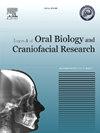Antioxidants for the management of oral leukoplakia: A systematic review of randomized controlled trials
Q1 Medicine
Journal of oral biology and craniofacial research
Pub Date : 2025-03-11
DOI:10.1016/j.jobcr.2025.03.001
引用次数: 0
Abstract
Introduction
Oral leukoplakia (OL) is a potentially malignant disorder characterized by non-scrabble white lesions that may turn into invasive carcinoma if left untreated. Few antioxidant treatments have shown promising results in the regression of lesions and prevention of their progression to carcinoma. We aim to summarize the current evidence on the effectiveness of antioxidants in the management of OL.
Materials and methods
The present systematic review followed PRISMA guidelines and involved a thorough search of three scientific databases: PubMed, Scopus, and Cochrane. We used specific algorithms related to the keywords “antioxidant” and “Oral leukoplakia” to identify randomized controlled trials (RCTs) that have explored the utility of antioxidants in the management of OL. The risk of bias assessment was conducted using the Cochrane risk of bias tool (ROB 2.0), ensuring the reliability of our findings.
Results
Out of 2490 articles retrieved, only thirteen RCTs involving 1147 participants fulfilled the inclusion criteria. Lycopene was found to be the most consistently effective antioxidant, showing significant effectiveness in reducing lesion size, both in oral and topical forms. The trials incorporating other antioxidants, including vitamin A, vitamin C, β-carotene, and curcumin, demonstrated mixed results. Severe heterogeneity was detected in treatment forms, dosage, administration frequency, treatment duration, and follow-up time among all included trials.
Conclusion
Lycopene may play a significant role in the non-surgical management of OL. Future research with large-scale, well-designed, randomized controlled trials with standardized dosing, delivery methods, and outcome measures is mandatory to provide more robust evidence on the available antioxidant therapy for OL.

抗氧化剂治疗口腔白斑:随机对照试验的系统综述
口腔白斑(OL)是一种潜在的恶性疾病,其特征是非杂乱的白色病变,如果不及时治疗,可能转变为浸润性癌。很少有抗氧化治疗在病变消退和预防其进展为癌方面显示出有希望的结果。我们的目的是总结目前的证据对抗氧化剂的有效性在OL的管理。材料和方法本系统综述遵循PRISMA指南,并对PubMed、Scopus和Cochrane三个科学数据库进行了全面检索。我们使用与关键词“抗氧化剂”和“口腔白斑”相关的特定算法来识别探索抗氧化剂在OL管理中的效用的随机对照试验(rct)。偏倚风险评估采用Cochrane偏倚风险工具(ROB 2.0)进行,以确保我们研究结果的可靠性。结果在检索到的2490篇文献中,只有13篇rct(共1147名受试者)符合纳入标准。番茄红素被发现是最有效的抗氧化剂,在减少病变大小方面显示出显著的效果,无论是口服形式还是外用形式。试验中加入了其他抗氧化剂,包括维生素A、维生素C、β-胡萝卜素和姜黄素,结果喜忧参半。在所有纳入的试验中,在治疗形式、剂量、给药频率、治疗持续时间和随访时间方面存在严重的异质性。结论番茄红素可能在OL的非手术治疗中发挥重要作用。未来有必要开展大规模、精心设计的随机对照试验,采用标准化的剂量、给药方法和结果测量,以提供更有力的证据,证明抗氧化剂治疗OL的有效性。
本文章由计算机程序翻译,如有差异,请以英文原文为准。
求助全文
约1分钟内获得全文
求助全文
来源期刊

Journal of oral biology and craniofacial research
Medicine-Otorhinolaryngology
CiteScore
4.90
自引率
0.00%
发文量
133
审稿时长
167 days
期刊介绍:
Journal of Oral Biology and Craniofacial Research (JOBCR)is the official journal of the Craniofacial Research Foundation (CRF). The journal aims to provide a common platform for both clinical and translational research and to promote interdisciplinary sciences in craniofacial region. JOBCR publishes content that includes diseases, injuries and defects in the head, neck, face, jaws and the hard and soft tissues of the mouth and jaws and face region; diagnosis and medical management of diseases specific to the orofacial tissues and of oral manifestations of systemic diseases; studies on identifying populations at risk of oral disease or in need of specific care, and comparing regional, environmental, social, and access similarities and differences in dental care between populations; diseases of the mouth and related structures like salivary glands, temporomandibular joints, facial muscles and perioral skin; biomedical engineering, tissue engineering and stem cells. The journal publishes reviews, commentaries, peer-reviewed original research articles, short communication, and case reports.
 求助内容:
求助内容: 应助结果提醒方式:
应助结果提醒方式:


